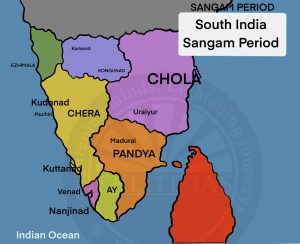Sangam Era Life and Polity
- The Sangam era which flourished during the third century BCE to the third century CE is significant in South Indian history as it is noted for its literary, artistic, and socio-political advancements.

Sangam Assembly
- There were three Sangam assemblies, according to traditional accounts: the First Sangam in Madurai, the Second Sangam at Kapatapuram, and the Third Sangam in Madurai.
- The first and third Sangam’s details are seen as being more legendary, whereas the second Sangam is seen as being more historical.
Sangam Polity
- A combination of localised chieftains and centralised monarchies made up the political system of the Sangam era. There were many lesser chieftains who held power over smaller regions, in addition to established dynasties like the Cheras, Cholas, and Pandyas that ruled over greater domains.
- The Cheras, Cholas, and Pandyas are known as the “Three Crowned Kings”. These kingdoms cooperated and competed with one another over territories and trade routes.
- Pandyas were the main Patrons of Sangam.
Economy and Trade
- The Sangam period witnessed extensive maritime trade with regions like the Roman Empire and Southeast Asia. Ports like Puhar (Kaveripattinam) and Muziris played a vital role in facilitating trade.
Landscape
|
Kurinji |
Hilly Tracts |
|
Mullai |
Pastoral |
|
Marudham |
Agriculture |
|
Neidhal |
Coastal |
|
Palai |
Desert |
Position of Women
- Women were treated with respect and consideration even if they did not have equal standing with males.
- Women were respected and allowed to pursue intellectual interests.
- Women poets flourished and contributed to Tamil literature, including Avvaiyar, Nachchellaiyar, and Kakkaipadiniyar.
- Women were given the right to choose their life partners. However, widows’ lives were wretched.
- Chastity was regarded as the highest virtue for women. Kannagai, the protagonist of Silappadikaram (by Ilango Adigal), for example, emphasises the significance of chastity.
- Love marriages were widespread, and women had the right to pick their partners.
- Sati was practised in the upper classes.
Religious practices
- The Sangam people were religious, with Murugan as their chief deity.
- Indra and Vishnu worship was also prominent.
- There was also a belief in sacred or mystical energies known as Ananku.
- During the Sangam period, the Hero-Stone (Virakal) or Nadu Kal worship was also practised.
- Buddhism and Jainism were also present in the area.
